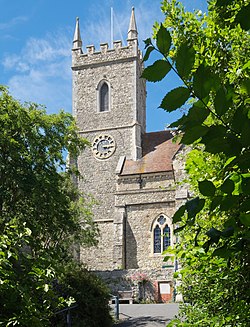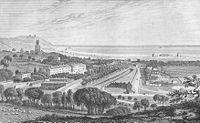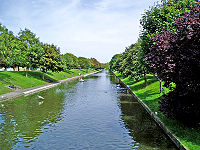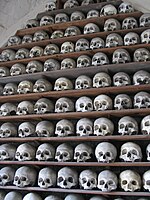Hythe, Kent
| Hythe | |
| Kent | |
|---|---|
 St Leonard's church | |
| Location | |
| Grid reference: | TR158350 |
| Location: | 51°4’18"N, 1°5’2"E |
| Data | |
| Population: | 14,170 |
| Post town: | Hythe |
| Postcode: | CT21 |
| Dialling code: | 01303 |
| Local Government | |
| Council: | Folkestone & Hythe |
| Parliamentary constituency: |
Folkestone and Hythe |
Hythe is a small coastal market town on the south coast of Kent, on the edge of Romney Marsh. Its name simply means "Haven" or "Landing Place".
The town has mediæval and Georgian buildings, and an Anglo-Saxon / Norman church on the hill and seafront promenade. Hythe was once defended by two castles, Saltwood and Lympne. The town hall, a former guildhall, was built in 1794, its fireplace designed by the Adam Brothers.
Hythe's market once took place in Market Square (now Red Lion Square) close to where there is now a Farmers' Market every second and fourth Saturday of the month. Hythe has gardening, horse riding, bowling, tennis, cricket, football, squash and sailing clubs. Lord Deedes was patron of Hythe Civic Society, and the hounds of The East Kent Hunt are kennelled in nearby Elham.
Hythe is one of the Cinque Ports, but although it is beside a broad bay on the English Channel, silting removed its harbour hundreds of years ago. Hythe was once the central Cinque Port, between Hastings and New Romney to the west and Dover and Sandwich to the east.
According to Edward Hasted, a French fleet approached Hythe in 1293 and landed 200 men, but "the townsmen came upon them and slew every one of them: upon which the rest of the fleet hoisted sail and made no further attempt".
In 1348 the Black Death afflicted Hythe, and in 1400 the plague further reduced the population.
Contents
The Royal Military Canal and Martello Towers
The Royal Military Canal runs across the northern edge of the marsh, to Winchelsea. Running under Stade Street, the canal, intended to repel invasion during the Napoleonic Wars of 1804 to 1815, gives central Hythe its character. Now shaded by trees, the canal, 30 feet wide passes into the marsh from the middle of the town. The canal begins at Seabrook and runs through Hythe and across Romney Marsh to Winchelsea. Its 26-mile length can be walked.
Also built around the same time as a defence against possible invasion by Napoleon were the Martello Towers. In total 74 of these towers were built between Folkestone and Seaford. The walls were up to 13 feet thick, and each tower held 24 men and had a huge cannon mounted on the top. They were named after a similar tower at Mortella Point in Corsica which the Navy had captured from the French. Although never needed for their original purpose they were later used to combat smuggling and also as signalling stations and coastal defences during the two World Wars. Three of the towers survive at Hythe; one was converted to a house in the 1930s and can be seen along West Parade, and the other two are on the beach and are owned by the Ministry of Defence.
Geologically the town developed on a succession of non parallel terraces, rising from the level ground around the Royal Canal towards the steep incline upon which the parish church of St Leonard was built. From the High Street, alleys lead up to the steeper levels of the town.
Parish Church
The parish church is St Leonard's, a large 11th-century church up the hill. The tower at its eastern end was destroyed by an earth tremor in 1739 and restored in 1750.
The chancel, from 1220, covers a processional ossuary (a bone store, more commonly found on the continent) lined with 2,000 skulls and 8,000 thigh bones. They date from the mediæval period, probably having been stored after removal, to make way for new graves. This was common in England, but bones were usually dispersed, and this is thus a rare collection.
Lionel Lukin, credited with inventing the self-righting lifeboat, is buried in the parish churchyard.
The castles at Saltwood and Lympne
Hythe was once defended by two castles, Saltwood and Lympne. Saltwood Castle derives its name from the village of Saltwood in its shadow. During the reign of king Canute the manor of Saltwood was granted to the priory of Christ Church in Canterbury, but during the 12th century it became home of Henry d'Essex, constable of England.
Thomas Becket had sought from King Henry II restoration of the castle as an ecclesiastical palace. Henry instead granted the castle to Ranulf de Broc. The castle was in time returned to Becket, as Archbishop of Canterbury, and remained a church property until the reign of Henry VIII, when Hythe and Saltwood were to be sequestrated to the Crown. It was during his time at Saltwood, on 28 December 1170, that four knights plotted Becket's death the following day.
When Hythe came under Crown control, the senior official of the town was also a bailiff appointed by the Crown. This state of affairs (uniquely for a Cinque Port) remained until 1575 when Elizabeth I gave the town control of its affairs. The last Crown bailiff, John Bredgman, became the first mayor. A brass inscription bearing his name remains in the parish church, dated 1581.
The Cinque Port Court of Shepway
A monumental cross now indicates what was from 1358 a meeting place of the confederation of the Cinque Ports, several miles west of Hythe, known then as "the Shepway crossroads". Shepway cross, erected in 1923, the monument to the Court of Shepway, is beside the Hythe to Lympne road (B2067). The Lathe of Shepway is the division of Kent in the south-east of the county, within which lie Folkestone, Hythe, Romney Marsh and nearby villages as far north as Elham.
Many think this monument marks where the Lord Warden of the Cinque Ports held his court for Shepway, and it is referred to as the "Shepway Cross". In fact the Shepway Cross is a civic war memorial erected in 1923. It was placed on the top of Lympne Hill because that was traditionally the site of the Court of Shepway.
Shepway Cross was paid for and unveiled in August 1923 by Earl Beauchamp, the Lord Warden of the Cinque Ports. The Archbishop of Canterbury, Randall Davidson, attended the ceremony. The memorial now shows signs of decay. The lettering denoting the monument's true purpose is hardly legible.
The Romney, Hythe and Dymchurch Railway
Hythe is the northern terminus of the Romney, Hythe and Dymchurch Railway, running third-scale steam and diesel locomotives. The track runs parallel to coast through Dymchurch and New Romney to Dungeness. The founders were Captain J Howey and Count Louis Zborowski. It opened in 1927. The trains run on a gauge of 15 inches in width, and the track is nearly 14 miles long. During the Second World War the service transported the Operation Pluto pipeline.
Big Society
Hythe Town Band
Very little is known about the band's formative years except that reference is made in a press article of August 1890 to the formation of a 'Brass and Reed Band' from the existing town band which had, at that time, been running for at least ten years.
In August 1891 the band gave a notable public performance which prompted the following comment in the local press:
The Hythe Town Band played in front of the Sea View Hotel, Seabrook, last Tuesday from 8 - 10pm. This is the first time the band has appeared in uniform, which is very similar to the undress uniform of the East Kent Volunteers, excepting that it is a little neater!
In 1894 the band's name was changed to the Hythe Town Military Band. At the turn of the century the band split up after disagreements and in September 1900 some musicians broke away to form the Hythe Excelsior Band. By 1903 it would seem that whatever had caused the rift had been resolved and the two bands decided to amalgamate and during that year gave 89 public performances.
A successful period followed and by the 1920s the band had won an impressive list of competitions and medals. There had also been occasions when the band played to support public appeals, possibly the most notable being in 1912 when the band took to the streets to raise money for the relatives of the victims of the Titanic.
In 1939 the band dissolved up as the fittest members joined the Navy and the Army. It was resurrected in 1945 and was able to be ready to play for the VE Day celebrations. As the Hythe Town Military Band it continued to play until the early 1990s when the name once again changed to the current name: Hythe Town Concert Band.
Events
Every two years, Hythe Corporation hosts the Hythe Venetian Fete, when organisations and individuals create decorated floats which travel up and down the Royal Military Canal.
Theatre
The Folkestone & Hythe Operatic & Dramatic Society owns the Tower Theatre at Shorncliffe. It is a charitable organisation which performs several shows a year.
About the town
- Brockhill Country Park
- Centuries
- Port Lympne Zoo
- Romney, Hythe and Dymchurch Railway
Media
- Newspapers:
- The Hythe Herald
- The Kentish Express
- Folkestone and Hythe Extra
- yourshepway
- Magazine: "Folkestone, Hythe & Romney Life"
- Radio
- KMFM Shepway and White Cliffs Country
Outside links
- Hythe Town Band
- The Tower Theatre website
- Information on the area by local resident
- Hythe, Kent
- Hythe Town FC
References
| The Cinque Ports | ||
|---|---|---|
| Cinque Ports | Antient Towns | Limbs |
|
Hastings • New Romney • Hythe • Dover • Sandwich |
Lydd • Folkestone • Faversham • Margate • Deal • Ramsgate • Brightlingsea • Tenterden | |


